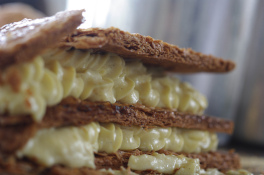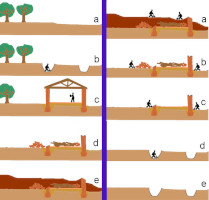Archaeologists are Food Lovers
- Last Updated: Tuesday, 28 June 2022 09:50
- Published: Thursday, 17 February 2022 09:26
- Written by Jean-Olivier Gransard-Desmond translated by Marine Bidault and Maura Schmitt
- Hits: 5244
Join Augustin, Alex, Lisa and the whole ArkeoTopia team to discover additional resources for step 5.2 in My Archaeology Book about stratigraphy, a tool for archaeological excavation.
Step 5.2 - Fieldwork
Understanding Stratigraphy
Corresponding pages in MAB1 and MAB2
MAB1, p. 16 and MAB2, p. 20
More about this step’s reference artifact
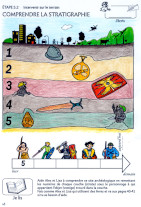 The location used to illustrate pages 16 and 20 of My Archaeology Book, titled Field Research - Understanding Stratigraphy, is not real. The stratigraphical illustration in My Archaeology Book was invented to explain how this tool, borrowed from geology, can provide information to archaeologists.
The location used to illustrate pages 16 and 20 of My Archaeology Book, titled Field Research - Understanding Stratigraphy, is not real. The stratigraphical illustration in My Archaeology Book was invented to explain how this tool, borrowed from geology, can provide information to archaeologists.
During archaeological excavations, stratigraphy proves to be a fundamental tool for archaeologists. It enables them to understand every single stratum, or layer, which built up over time. Thanks to stratigraphy, archaeologists can turn back time and put a date on each discovery. They can also study relationships between layers so they can understand which one impacted the other to get useful information to recreate the sediments.
As archaeologists are unable to anticipate how many layers they will find, they number them starting with current soil. Consequently, the oldest layers always bear bigger numbers, as they are the ones at the bottom of the hole they dug, whereas the most recent layers bear smaller numbers.
Take as an example a Napoleon cake or lasagna. To reach the last layers, though they were the first to be formed during the preparation of the meal, the immediately accessible layers must be removed first. They were the last to be added but the first to be removed. In archaeology, this can be seen in the figure below where a human being builds a house on the left of the drawing. To discover the gradual construction and destruction of this house, it would be necessary to start from the last picture, which becomes the first for archaeologists, in order to get back to the first one, the virgin soil. Here, stratigraphy is used to understand how sediments build up and how humans affect this process.
Stratigraphy brings with it the necessity to destroy the location where archaeologists work. Indeed, to reach the virgin soil, that is to say the still natural one that humankind never tread on, archaeologists have to destroy all the upper layers first. For buildings, it means destroying the site itself. The layers do not often follow one another as distinctly as in the drawing in My Archaeology Book. Burrowing animals, weasels, rabbits and many other animals move things and impact relationships between layers, with Diggy the mole who embodies archaeologists. Other agents can impact the stratigraphic layers. Human buildings themselves can cause change. This is the case for post holes or trenches for foundations. Natural events (mudslides, volcanic eruptions, tidal waves, etc.) can also be a source of change.
The layers do not often follow one another as distinctly as in the drawing in My Archaeology Book. Burrowing animals, weasels, rabbits and many other animals move things and impact relationships between layers, with Diggy the mole who embodies archaeologists. Other agents can impact the stratigraphic layers. Human buildings themselves can cause change. This is the case for post holes or trenches for foundations. Natural events (mudslides, volcanic eruptions, tidal waves, etc.) can also be a source of change.
The stratigraphic cross-section in My Archaeology Book was designed simply to be more accessible. It shows the temporal relations in the ground, from the surface layer, represented by the city and the countryside, under which is:
- Layer or stratum 1 containing an Adrian helmet that a French soldier might have used, which is an artifact from WWI (beginning of the 20th century) and so from the late modern period;
- Layer or stratum 2 containing a sextant that Christopher Columbus might have used, which is an artifact from the conquest of the Americas (end of the 15th century) and so from the early modern period;
- Layer or stratum 3 containing a shield that a Roman soldier might have used, which is an artifact from the 1st century BCE and so from the classical period;
- Layer or stratum 4 containing a human-shaped X-hilt sword that a Celtic warrior might have used, which is an artifact from 60 BCE and so from the classical period too, but earlier;
- Layer or stratum 5 containing a biface, or stone tool, that a prehistoric being might have used, which is an artifact from 1.6 million BCE and so from the Old Stone Age (ancient period).
BE CAREFUL, stratigraphy does not only work horizontally speaking but also vertically speaking. This is especially true regarding the study of buildings, whether it is for removing wallpapers, paint, primers, etc. The paper "Building Archaeology Informative Modelling Turned into 3D Volume Stratigraphy and Extended Reality Time-Lapse Communication" published in 2022 in Virtual Archaeology Review (p. 7-9 and 12) provides quite clear illustrations.
Clues
The 7 clues, from MAB1 for kids ages 5 to 8, include:
- Diggy the mole, shown once with her hard hat and once with her trowel (these two versions of Diggy represent one activity of archaeologists: excavation)
- The shadow puppet-style silhouette of a city and part of the countryside, which represents the surface layer under which other layers and strata of different periods containing remains of Human History are
- Layer or stratum 1 and its artifacts
- Layer or stratum 2 and its artifacts
- Layer or stratum 3 and its artifacts
- Layer or stratum 4 and its artifacts
- Layer or stratum 5 and its artifacts
The 7 clues, from MAB2 for kids and teens ages 8 to 14, include:
- Diggy the mole, a burrowing animal who represents excavation, one activity of archaeologists
- the shadow puppet-style silhouette of a city and part of the countryside, which represents the surface layer under which other layers and strata of different periods containing remains of Human History are
- Layer or stratum 1 and its artifacts
- Layer or stratum 2 and its artifacts
- Layer or stratum 3 and its artifacts
- Layer or stratum 4 and its artifacts
- Layer or stratum 5 and its artifacts
Building ArchaeoMy Archaeology Book
Resources HomepageStep 5.3 - Fieldwork
Underwater Excavation
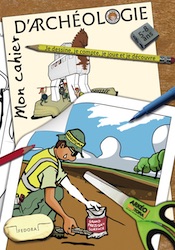 |
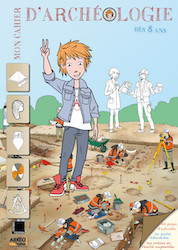 |
|
My Archaeology Book 1 |
My Archaeology Book 2 |

 My Archaeology Book, or MAB, is an activity workbook that combines creativity, fun and learning. Alongside young Augustin, a curious and courageous boy, children meet Alex and Lisa, two friendly archaeologists who will lead them to discover archaeology and French heritage. Each drawing illustrates a situation that Alex and Lisa might encounter at work. Depending on the age of the child and the workbook, children follow easy-to-understand symbols in order to experiment with activities such as coloring, drawing, observation games, riddles and reading in order to see the world through an archaeologist’s eyes. Alone, with family, at school or just for fun, children expand their knowledge and gain skills, all while having fun.
My Archaeology Book, or MAB, is an activity workbook that combines creativity, fun and learning. Alongside young Augustin, a curious and courageous boy, children meet Alex and Lisa, two friendly archaeologists who will lead them to discover archaeology and French heritage. Each drawing illustrates a situation that Alex and Lisa might encounter at work. Depending on the age of the child and the workbook, children follow easy-to-understand symbols in order to experiment with activities such as coloring, drawing, observation games, riddles and reading in order to see the world through an archaeologist’s eyes. Alone, with family, at school or just for fun, children expand their knowledge and gain skills, all while having fun.
On this section, you will find additional resources: color photos of archaeological documents that inspired My Archaeology Book, additional teaching documents (flip-book, websites, suggestions for classroom use, edutainement, etc.) and information on upcoming publications. Each page will be updated over time.






